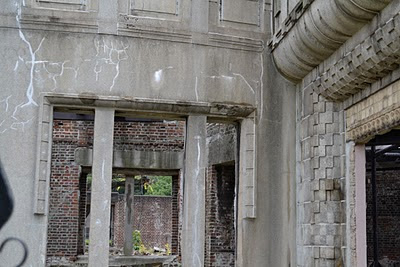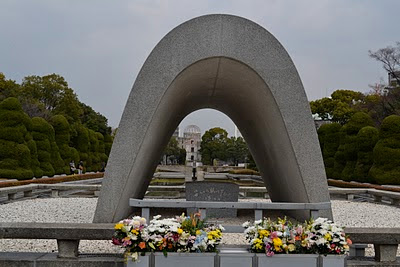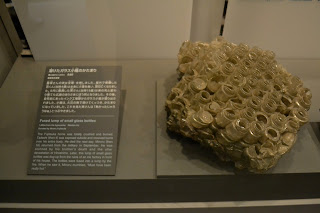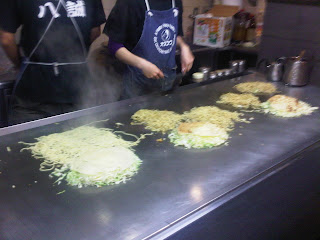Years ago, as a college student, I watched the movie
Hiroshima Mon Amour over and over again. It appealed to my youthful infatuation with existentialism, time, memory and, of course, love. It also was my first exposure to footage of the bombing of Hiroshima in 1945 and to the perspective of the Japanese about that bombing. (It may also be one of the sources of my distress about losing my hair last year, given that the movie poignantly portrays loss of hair, both by victims of the bomb in Hiroshima and by the French woman protagonist as the result of her affair with a German soldier during WW2.) This experience undoubtedly has fueled my long time interest in visiting Hiroshima, so I made sure it was on our list of places to see during our recent whirlwind trip of Japan.
We arrived late on December 10, 2010 (Human Rights Day) in Hiroshima after spending a lovely afternoon in Okayama with our friend Noriko. Noriko told us that her dad was stationed outside Hiroshima in Ujina when the bomb fell and his friends went into Hiroshima right afterwards on search and rescue missions. Those men and boys got radiation sickness and cancers. Noriko's dad was spared and later wrote a long book with Noriko about the survivors of the atomic bombing. He died a few years ago. Noriko remains a peace activist, adamantly opposed to nuclear weapons and nuclear energy.
Our taxi driver from the JR station to the
Righa Royal Hotel, near the
Peace Memorial Park, was an older man, originally from Hawaii with an American father and Japanese mother. He spoke decent English and charmed us with his story of how he came to live in Japan. I kept wondering if his mother was in Hawaii during the war or whether she wound up there afterward. It was clear from that moment that our journey to Hiroshima was a journey to the past, with shadows of ignominy of the disaster other Americans hath wrought in Japan.
In the morning, I looked out over the city from our hotel perch. It is humbling to think that we were blocks from ground zero and 65 years ago nothing was standing for miles around other than a few buildings, most notably the structure now called the
Atomic Bomb Dome (A-Bomb Dome) which was about 500 feet from ground zero. We wandered out that morning and first looked at the Dome, a chilling site in the gray sky. In front, a group of Japanese tourists were getting a lecture about the bombing. The tour guide had pictures of Enola Gay; again I felt uncomfortable being an American at that moment.
 |
| A-Bomb Dome with reflection |
 |
| A-Bomb Dome |
 |
| weeds and plants grow within the A-Bomb Dome |
Starting in 1944, Japan conscripted children over the age of 12 to serve in support positions to the military for the war. In the Memorial Park, there was one monument to those conscripted Japanese children who died during the war and another monument (Children's Peace Monument) for the children who died as a result of the atomic bomb including Sadako Sasaki, who died of leukemia at age 12, ten years after she lived through the atomic bombing.
 |
| Memorial Tower to Mobilized Students |
 |
| Children's Peace Monument |
 |
| Memorial Monument For Hiroshima City of Peace "Let all the souls here rest in peace for we shall not repeat the evil. " |
The
Peace Memorial Museum was chilling, particularly the photographs and the tattered clothes of those (many of whom were children) who were nearby at the time of the blast and eventually died of radiation sickness a few days later. There was a chilling display about black rain, which people drank because the heat from the bomb made them so thirsty. Other chilling sights were the two watches stopped at 8:16, the time in the morning of August 6, 1945 when the bomb
purportedly hit.
 |
| Photo taken a few months after bombing |
 |
| Photo after bombing shows epicenter of blast |
 |
| Clothing of children near blast |
 |
| More clothing |
 |
| Glass bottles fused by heat from blast |
 |
| Watch stopped at 8:16 |
After lunch, we needed an emotional break so we got a taxi to
Hassei, which reportedly had the best okonomiyaki in Hiroshima. We walked a bit and came upon an outdoor shopping mall filled with Christmas shoppers and revelers. Quite a contrast to the sadness of our morning in the Peace Memorial Park and Museum. We sat for some time in a Starbucks and watched the holiday scene. Life goes on and horror commingles with joy. An interesting lesson, not unlike some of those in
Hiroshima Mon Amour.
 |
| Cooking okonomiyaki at Hassei |
 |
| Shopping mall in Hiroshima |



No comments:
Post a Comment